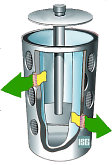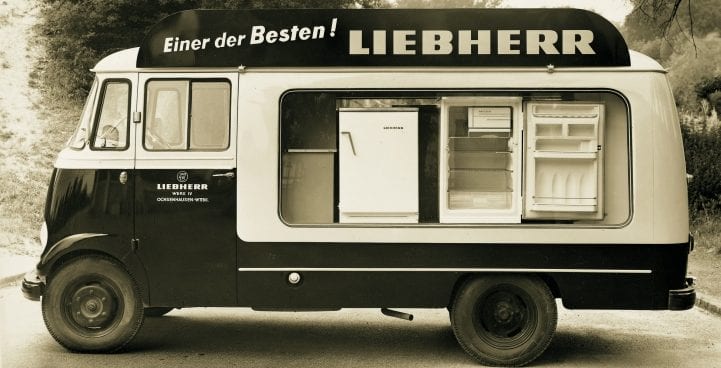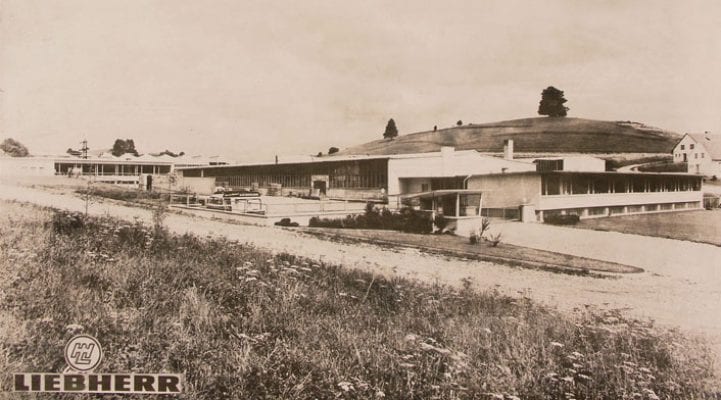Do you know how the refrigerator was invented
Do you know how the refrigerator was invented
Who Invented the Refrigerator?
By Rachel Ross published 8 February 17
Refrigeration is the process of creating cooling conditions by removing heat. It is mostly used to preserve food and other perishable items, preventing foodborne illnesses. It works because bacteria growth is slowed at lower temperatures.
Methods for preserving food by cooling have been around for thousands of years, but the modern refrigerator is a recent invention. Today, the demand for refrigeration and air conditioning represent nearly 20 percent of energy consumption worldwide, according to a 2015 article in the International Journal of Refrigeration.
History
The Chinese cut and stored ice around 1000 B.C., and 500 years later, the Egyptians and Indians learned to leave earthenware pots out during cold nights to make ice, according to Keep It Cool, a heating and cooling company based in Lake Park, Florida. Other civilizations, such as the Greeks, Romans and Hebrews, stored snow in pits and covered them with various insulating materials, according to History magazine. In various places in Europe during the 17th century, saltpeter dissolved in water was found to create cooling conditions and was used to create ice. In the 18th century, Europeans collected ice in the winter, salted it, wrapped it in flannel, and stored it underground where it kept for months. Ice was even shipped to other locations around the world, according to a 2004 article published in the journal of the American Society of Heating, Refrigeration, and Air-Conditioning Engineers (ASHRAE).
When ice wasn’t available or practical, people used cool cellars or placed goods underwater, according to History magazine. Others built their own ice boxes, according to Keep It Cool. Wooden boxes were lined with tin or zinc and an insulating material such as cork, sawdust, or seaweed and filled with snow or ice.
Evaporative cooling
The concept of mechanical refrigeration began when William Cullen, a Scottish doctor, observed that evaporation had a cooling effect in the 1720s. He demonstrated his ideas in 1748 by evaporating ethyl ether in a vacuum, according to Peak Mechanical Partnership, a plumbing and heating company based in Saskatoon, Saskatchewan.
Oliver Evans, an American inventor, designed but did not build a refrigeration machine that used vapor instead of liquid in 1805. In 1820, English scientist Michael Faraday used liquefied ammonia to cause cooling.
Jacob Perkins, who worked with Evans, received a patent for a vapor-compression cycle using liquid ammonia in 1835, according to History of Refrigeration. For that, he is sometimes called the «father of the refrigerator.»
John Gorrie, an America doctor, also built a machine similar to Evans’ design in 1842. Gorrie used his refrigerator, which created ice, to cool down patients with yellow fever in a Florida hospital. Gorrie received the first U.S. patent for his method of artificially creating ice in 1851.
Other inventors around the world continued to develop new and improve existing techniques for refrigeration, according to Peak Mechanical, including:
The popularity of commercial refrigeration grew toward the end of the 19th century due to breweries, according to Peak Mechanical, where the first refrigerator was installed at a brewery in Brooklyn, New York, in 1870. By the turn of the century, nearly all breweries had a refrigerator.
The meatpacking industry followed with the first refrigerator introduced in Chicago in 1900, according to History magazine, and almost 15 years later, nearly all meatpacking plants used refrigerators.
Refrigerators were considered essential in homes by the 1920s, according to History magazine, and more than 90 percent of American homes had a refrigerator.
Today, nearly all homes in the United States — 99 percent — have at least one refrigerator, and about 26 percent of U.S. homes have more than one, according to a 2009 report by the U.S. Department of Energy.
How does a refrigerator work?
Refrigerators today work very similarly to refrigerators over a hundred years ago: by evaporating liquids, according to SciTech. Refrigerants, the liquid chemicals that are used to cool, evaporate at low temperatures.
The liquids are pushed through the refrigerator through tubes and begin to vaporize. As the liquids evaporate, they carry heat away with them as the gases travel to a coil on the outside of the refrigerator, where the heat is released. The gases are returned to a compressor, where they become liquid again, and the cycle repeats.
Refrigerator safety
Early refrigerators used liquids and gases that were flammable, toxic, highly reactive or a combination, according to the U.S. Environmental Protection Agency (EPA). Thomas Midgley, an American engineer and chemist, researched safer options in 1926 and found that compounds containing fluorides appeared to be a great deal safer. Chlorofluorocarbons (CFCs), marketed by DuPont as Freon, grew in popularity, until the compounds were found to be harmful to the ozone layer in the atmosphere nearly 50 years later.
Most of the refrigerators manufactured today use hydrofluorocarbons (HFCs), according to the California Energy Commission, which are safer than CFCs and many other options, but still not the most ideal. The EPA keeps an updated list of acceptable materials that can be used in refrigerators as a coolant.
Refrigerators keep food safe, but only if operating at proper temperatures, according to the U.S. Food and Drug Administration. When refrigerators aren’t kept cold enough, harmful bacteria within perishable foods grow rapidly and can contaminate the food, causing mild irritations to severe food poisoning if it is eaten. The FDA recommends that a refrigerator’s temperature be set at a maximum of 40 degrees Fahrenheit (4.4 degrees Celsius); also, the refrigerator should not be not overly packed, and spills should be promptly cleaned.
Refrigerators of the future
New technologies in refrigeration include solid-state refrigerators and refrigerators that use magnets.
Traditionally, refrigerators have relied on large compressors, which generate a lot of heat and can easily heat up a room, said Tony Atti, CEO of Phononic, an electronics manufacturer based in Durham, North Carolina. The company gets its name from the theory of phonons, quantum particles that carry heat.
Solid-state refrigerators use the entire surface of the refrigerator to very slowly and deliberately dissipate the heat so that an increase in temperature of the room is practically nonexistent and the surface of the refrigerator is cool to the touch, Atti told Live Science. These refrigerators also have the benefit of being free from harmful materials and loud operations, as well as being more accurately controlled.
Another new type of refrigerator uses magnets to provide a vibration-free, silent, environmentally friendly refrigerator. Built by Haier in conjunction with BASF and Astronautics, the magnetic refrigerator uses a concept based on the magnetocaloric effect, discovered in 1917 by Pierre Weiss and Auguste Piccard, French and Swiss physicists respectively, according to an article (opens in new tab) by Andrej Kitanovski, et al., a group of scientists from Slovenia and Denmark, in 2015 and published by Springer International Publishing.
According to a press release on PR Newswire, proper red wine storage has very specific needs in order to maintain the taste and quality. The Haier refrigerator uses magnetocaloric heat pump (using a material that heats up in a magnetic field and cools down when it is not) with a water-based coolant, according to a news release on BASF, which relies on abundant and affordable raw materials. The magnetic refrigerator also uses up to 35 percent less power than traditional refrigerators.
Additional resources
Rachel Ross is a science writer and editor focusing on astronomy, Earth science, physical science and math. She holds a Bachelor of Arts in Philosophy from the University of California Davis and a Master’s degree in astronomy from James Cook University. She also has a certificate in science writing from Stanford University. Prior to becoming a science writer, Rachel worked at the Las Cumbres Observatory in California, where she specialized in education and outreach, supplemented with science research and telescope operations. While studying for her undergraduate degree, Rachel also taught an introduction to astronomy lab and worked with a research astronomer.
Do you know how the refrigerator was invented
Once a genuine luxury, now an indispensable standard: The ability to cool food in a refrigerator or freezer, keeping it fresh for an extended period of time.
Read on to find out how this all came to be.
‘Once upon a time…’ is a well-known fairy tale opening that could easily be used to start the story of the refrigerator. Do you know how people stopped food from perishing 100 years ago? Or even before that, when there were no refrigerators and freezers as we know them today?
So let’s begin this tale: Once upon a time…
…going a long way back to the days of the hunter-gatherers, any food that was hunted or gathered was eaten straight away. The idea of cooling food was a long way off. Our ancestors gradually gave up their nomadic lifestyle and stopped being on the ‘hunt’ for food, so the situation started to change. As people settled, they had to find ways of keeping food fresh. They started to develop a range of solutions including smoking, curing and pickling foods. In the Middle Ages, niches in wooden walls provided a certain degree of coolness for food storage, as did streams, ponds, and holes dug in the ground. A cool cellar was an ideal place to keep perishable food fresh for longer. Foods were stored in wooden or clay containers.
Development of the Refrigerator
In 1748, William Cullen gave the first ever demonstration of artificial cooling at the University of Glasgow. The chemical refrigerator was developed and brought to the commercial market in 1834. Ferdinand Carré made further refinements in 1859. However, refrigerators were far away from being a standard feature in private homes. People stored food in a simple wooden crate containing blocks of ice and insulation materials. This explains the origin of the term ‘ice box’, which we still use today to refer to refrigerators. Along came Carl von Linde. His Gesellschaft für Lindes Eismaschinen AG (Linde’s Ice Machine Company) played a key role in the development of refrigerators from the 1870s onwards. Later technical and chemical advances saw refrigerators become a standard feature in American private households by the 1930s.
Refrigerators Save People Time
In Germany, refrigerators remained a genuine luxury item for many years to come. They were too expensive and bulky for the average household. Many households didn’t even have electricity at that time. Many villages and communities relied on communal cooling houses where fruit, vegetables, meat and other types of food could be stored. This was quite simply much cheaper. It wasn’t until the 1950s that refrigerators really took off in Germany. They eliminated the need for hours of pre-cooking and daily trips to the shops. Soon, refrigerators were being referred to as ‘every woman’s best friend’. There’s no doubt these ‘new friends’ offered a few advantages to men as well…
Meals instantly became far more varied. Cream cakes, cold cuts, fruit and other tasty delights were now all being enjoyed in the days of post-war ‘Wirtschaftswunder’ Germany.
Liebherr Enters the Refrigeration Sector
The early days of refrigerator production at Liebherr. The Ochsenhausen plant in 1959.
The first Liebherr refrigerator was produced in 1954. At this time, despite the economic miracle, 90% of German households didn’t own an electric refrigerator. Company founder Hans Liebherr saw an opportunity to enter the sector by developing, manufacturing, and continually improving, quality appliances. By the 1970s, refrigerators had become a standard and integral part of the home. First came freestanding, individual appliances. Then built-in models were gradually introduced to the market, and combination fridge-freezers became available. As the years went by, Liebherr became a well-known refrigeration specialist, continually developing new technology and innovations in the refrigeration and freezing sector. NoFrost technology, launched in 1987, is a prime example. NoFrost prevents the inside of the freezer compartment from frosting over. With its introduction, arduous and time-consuming defrosting became a thing of the past.
Added Convenience Thanks to NoFrost and BioFresh Technology
After NoFrost came BioFresh technology. Patented by Liebherr in 1996, a near 32°F zone incorporated in the refrigerator guarantees even greater freshness and convenience. Appliances with BioFresh technology offer the opportunity to keep fruit, vegetables, fish, meat and dairy products fresher for much longer than had previously been possible. Different types of food have different temperature and humidity requirements. These need to be met if the food’s flavor, vitamin content, texture and appearance are to be retained. BioFresh technology provides just the right conditions to prolong optimum storage. For example, a lettuce will stay fresh for 13 days in a Liebherr BioFresh compartment but for only 5 days in a normal refrigerator compartment.
Over the years, Liebherr also developed into an industry-leader in the fields of design and energy efficiency. By employing environmentally friendly refrigerants, highly efficient compressors and new insulation materials, Liebherr earned the coveted ENERGY STAR “Most Efficient” designation for 2016. It’s the sixth year in a row that various Liebherr models have received this honorable distinction.
The Growing Importance of Design
The Liebherr Side-by-Side-Model SBSbs 7263 received the coveted iF Design Award 2015.
Since 2010, all appliances in Europe have to be labelled with a standardized energy label. Containing information about product energy consumption, the labels show consumers at a glance how much energy an appliance consumes. The more + signs after a letter, the more energy efficient the appliance. A++ appliances are 21% more energy efficient than A+ appliances, and A+++ appliances are as much as 48% more energy efficient. Liebherr is setting the bar even higher with a model which is around 20% more energy efficient than the A+++ standard threshold, consuming only 130-kilowatt hours of electricity per year (kWh/p.a.).
Let’s not forget the ‘small’ matter of design: Liebherr appliances regularly win design accolades from independent awarding bodies. In January this year, the BlackSteel Side-By-Side 7263 received the prestigious iF Design Award 2015.
The ‘normal’ refrigerator has evolved a great deal. It is more than just an appliance for cooling food. Refrigerators have been gradually transforming from purely functional items into design centerpieces. The trend has been for modern kitchens to become open ‘communication zones’. As a result, freestanding appliances with stylishly attractive finishes (such as BlackSteel or stainless steel) and design-enhancing technologies (such as energy-efficient LED interior light columns) have become design objects and visual highlights in the kitchen.
So where will we go next? How do you think refrigerators will develop in the future? Will they help us to manage our supermarket visits by giving us warnings when we are running low on things – and reorder for us? Whatever happens: The refrigerator’s journey is far from over and plenty of adventures still await! One thing is certain: Development won’t stop and Liebherr will keep supplying you with innovative, high-quality appliances meeting all your refrigeration needs.
Do you have any questions or comments about this post? Or do you have a story to tell about the history of refrigeration? Please let us know. Contact us on Facebook or use the comment function at the bottom of this post.
Do you know how the refrigerator was invented
B11
Do you know how the refrigerator was invented? It is one of the most important contributions of the Scots to the world.
CONTRIBUTE
B12
If James Harrison (1816-1893), a Scottish immigrant to Australia, didn’t accidentally push ether gas into a metal tube, people might still be using boxes filled with blocks of ice to cool their food.
ACCIDENTAL
B13
The main problem was how to overcome the need for ice in the refrigeration process.
REFRIGERATE
B14
COOL
B15
Australians had difficulty gaining access to natural ice since Australia does not enjoy that many lakes.
NATURE
B16
Harrison’s discovery was beneficial the world over, but especially important for Australia because now it could export frozen meat to Europe. He even tried one such journey to Europe, but the ether had leaked during the voyage and ruined the entire cargo. Harrison went bankrupt but his legacy meant a huge difference to the Australian economy.
DIFFER
Invention of the Refrigerator
There were more than a few inventors that filed patents for the invention of the refrigerator.
In fact, by the year 1880 there were over 3000 patents for refrigerators.
People used boxes filled with ice (iceboxes) to keep their food cool and keep it from spoiling. Iceboxes were lined with metal and insulated with straw, sawdust or cork.
Blocks of ice were stored in the top of the icebox so cold air would circulated downwards to keep the food cool. A drip pan or tap would be used to drain the melting water.
The ice industry was big business.
In the winter ice-harvesting companies would remove ice from frozen lakes and store it in ice-houses. Ice companies would ship ice around the country and throughout the world.
Horse drawn ice-wagons would deliver ice to homes and businesses. There were icebox manufacturing companies, icebox retailers, icebox agents.
You could get an inexpensive icebox or a deluxe hand-carved oak cabinet icebox.
When Was The Refrigerator Invented
When the first refrigerator was introduced in 1834 people didn’t buy them.
The invention threatened the profitable ice industry and they reacted by engaging in a strategy that questioned the safety of refrigerators. Allegations were made that refrigeration poisoned food because it used ammonia gas.
The public was reluctant to change.
It wasn’t until the mid-19th century when ice was contaminated from industrial pollution, that people began using refrigerators.
Refrigerators also changed from using ammonia to using chlorofluorocarbons.
Refrigeration completely wiped out the ice-box industry.
Who Invented The First Refrigerator
The first inventor of the refrigerator was Oliver Evans in 1805, however William Cullen invented the process in 1748 and Jacob Perkins invented more practical improvements in 1834.
Did you know that Albert Einstein patented an invention of the refrigerator. In 1903, Einstein invented an eco-friendly refrigerator that had no moving parts and didn’t use electricity.

This refrigerator invention doesn’t use energy. It doesn’t use electricity, solar photovoltaics, or batteries.
Made from household materials her invention maintains a temperature that preserves perishable foods and medicine.
It is a solar cooler that consists of two tubes with one inside the other. It uses solar heat and evaporation to create natural biological cooling. The principle is similar to how perspiration cools our bodies.
The inner tube is made of metal and is the receptacle used to store perishables. It also keeps the contents dry.

The inner tube is fitted inside the outer tube with a gap between them which is filled with sand, wool, soil or any material that will absorb water.
Solar energy (sunshine) heats the tube causing the water to evaporate from the gap material. This evaporation removes heat from the inner tube lowering the temperature inside to about 6ВєC (42ВєF).
Renewing the gap material with water keeps the cooler operating.
When she was 16, Emily Cummins from Keighley, West Yorkshire, won the Young Engineer for Britain Award for a toothpaste container she invented to help people who suffered from arthritis.
The following year she won the Sustainable Design Award for a portable water carrier she invented to help people in developing countries transport water.
A year later, Emily’s invention won the York Merchant Adventurers Award.
Emily has traveled to Africa to distribute her invention to those communities most in need of her cooler, where she is known affectionately by residents as «the fridge lady».
The history of the refrigerator: ancient origins to today
Food storage and preservation has always been a necessary part of human existence, and the refrigerator in your kitchen now represents thousands of years of refrigerator innovation. The history of the refrigerator includes natural preservation methods, technological advances and new features that help us keep our food cold more efficiently.
Select a link below to jump to a refrigerator history topic
How did people keep food cold before refrigerators?
Who invented the first refrigerator?
Why were home refrigerators invented?
What are some examples of refrigerator innovation?
Refrigerator innovation from Whirlpool Corporation
A cold cellar built into a hill beside a house
How did people keep food cold before refrigerators?
Ancient refrigeration
Depending on the climate, ancient civilizations preserved food using natural cooling methods available to them. People took advantage of rivers and lakes by storing food directly in the cold water or cutting ice for ice houses. Storage pits in the ground were filled with snow or ice and often covered with insulating materials like straw or sawdust.
Refrigeration without electricity
Ice houses on lakes and rivers were still effective ways to keep food cool before the invention of electricity. If ice or snow wasn’t an option, underwater or underground storage, like cold cellars, provided refrigeration. People also began building their own iceboxes for cold storage, using chunks of ice or snow in boxes insulated with natural materials like sawdust or seaweed.
Manufactured iceboxes that looked closer to modern refrigerators became popular in the 1800s. These designs consisted of insulated metal or wooden cabinet-type structures with a tray or compartment that held a large block of ice. These ice blocks were regularly delivered to households with iceboxes.
History of the Refrigerator
Timeline
Learn more about the history of the refrigerator with this refrigerator history timeline. Discover refrigerator innovation through the years.
Who invented the first refrigerator?
The first instance of artificial refrigeration was demonstrated by Scottish physician and professor William Cullen. In 1748, he observed and demonstrated the cooling effect of rapidly evaporating a liquid into gas, but did not put this method into practical use.
The modern mechanical refrigeration process we know today grew from the work of numerous inventors in the 1800s. American Jacob Perkins invented the first vapor compression system in 1834, while German professor Carl von Linde patented a new process for liquefying gases in the late 1800s. Refrigerator innovations led to widespread commercial refrigeration at the turn of the 20th century for industries like breweries and meatpacking plants.
In 1913, American Fred W. Wolf invented the first home electric refrigerator, which featured a refrigeration unit on top of an icebox.
Mass production of domestic refrigerators began in 1918 when William C. Durant introduced the first home refrigerator with a self-contained compressor.
Источники информации:
- http://blog.liebherr.com/appliances/us/how-it-all-began-the-history-of-the-refrigerator/
- http://www.your-teachers.ru/anglijskij/testy-ege/grammatika-2/07/test-08-po-ege-anglijskij-yazyk-otvet(2)
- http://www.inventor-strategies.com/invention-of-the-refrigerator.html
- http://www.whirlpool.com/blog/kitchen/history-of-the-refrigerator.html






